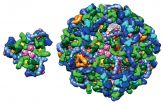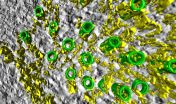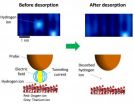A tunable, highly sensitive graphene-based molecule sensor
Researchers at EPFL and ICFO have developed a reconfigurable sensor made from graphene to detect nanomolecules such as proteins and drugs; the device exploits the unique electronic and optical properties of graphene
2015-07-10
(Press-News.org) Many areas of fundamental research are interested in graphene owing to its exceptional characteristics. It is made of one layer of carbon atoms, which makes it light and sturdy, and it is an excellent thermal and electrical conductor. Its unique features make it potentially suitable for applications in a number of areas . Scientists at EPFL's Bionanophotonic Systems Laboratory (BIOS) together with researchers from ICFO- The Institute of Photonic Sciences in Barcelona, have now harnessed graphene's unique optical and electronic properties to develop a reconfigurable highly sensitive molecule sensor. The results are described in an article appearing in the latest edition of the journal Science.
Focussing light to improve sensing
The researchers used graphene to improve on a well-known molecule-detection method: infrared absorption spectroscopy. In the standard method, light is used to excite the molecules, which vibrate differently depending on their nature. It can be compared to a guitar string, which makes different sounds depending on its length. By virtue of this vibration, the molecules reveal their presence and even their identity. This "signature" can be "read" in the reflected light. This method is not effective, however, in detecting nanometrically-sized molecules. The wavelength of the infrared photon directed at a molecule is around 6 microns (6,000 nanometres), while the target measures only a few nanometres. It is very challenging to detect the vibration of such a small molecule in reflected light.
This is where graphene comes in. If given the correct geometry, graphene is capable of focussing light on a precise spot on its surface and "hearing" the vibration of a nanometric molecule that is attached to it. In this study, researchers first pattern nanostructures on the graphene surface by bombarding it with electron beams and etching it with oxygen ions. When the light arrives, the electrons in graphene nanostructures begin to oscillate. This phenomenon concentrates light into tiny spots, which are comparable with the dimensions of the target molecules. It is then possible to detect nanometric compounds in proximity to the surface.
From ICFO, focussing on future industrial applications of this new sensor, Prof. Valerio Pruneri commented that "the concept can be used in different application fields, ranging from gas leakage, toxic and explosive gas sensing, and contaminants in water to DNA and proteins. This is because graphene is an inert material for the elements to be detected and the reading mechanism uses light which is free of any interference effect". "The beauty of this material lies in its simplicity of structure, which translates in an equally simple electro-optic response", adds ICFO Prof. Javier García de Abajo who contributed by first demonstrating theoretically its behaviour .
Reconfiguring graphene in real time to see the molecule's structure
In addition to identifying the presence of nanometric molecules, this process can also reveal the nature of the bonds connecting the atoms that make up the molecule. Graphene is able to pick up the sound given off by each of the strings because it is able to identify a whole range of frequencies. Researchers "tuned" the graphene to different frequencies by applying voltage, which is not possible with current sensors. Making graphene's electrons oscillate in different ways makes it possible to "read" all the vibrations of the molecule on its surface. "We tested this method on proteins that we attached to the graphene. It gave us a full picture of the molecule," said Hatice Altug.
A big step closer to using graphene for molecule sensing
The new graphene-based process represents a major step forward for the researchers, for several reasons. First, this simple method shows that it is possible to conduct a complex analysis using only one device, while it normally requires many different ones. And all this without stressing or modifying the biological sample. Second, it stresses graphene's incredible potential in the area of sensing.
INFORMATION:
Source :
Daniel Rodrigo, Odeta Limaj, Davide Janner, Dordaneh Etezadi, F. Javier García De Abajo, Valerio Pruneri, Hatice Altug Mid-Infrared Plasmonic Biosensing With Graphene, Science
Links :
The article in Science: http://www.sciencemag.org/content/349/6244/165.short
EPFL BioNanoPhotonic Systems Laboratory BIOS: http://bios.epfl.ch/
ICFO-The Institute of Photonic Sciences: https://www.icfo.eu/
Research group led by Prof. Javier Garcia de Abajo: https://www.icfo.eu/research/group_details.php?id=41
Research group led by Prof. Valerio Pruneri: https://www.icfo.eu/research/group_details.php?id=28
ELSE PRESS RELEASES FROM THIS DATE:
2015-07-10
Men may feel threatened by female supervisors and act more assertively toward them than male bosses, which could disrupt the workplace with struggles over power dynamics, according to new research published by the Society for Personality and Social Psychology.
"The concept of masculinity is becoming more elusive in society as gender roles blur, with more women taking management positions and becoming the major breadwinners for their families," said lead researcher Ekaterina Netchaeva, an assistant professor of management and technology at Bocconi University in Milan, ...
2015-07-10
Heidelberg, 10 July 2015 - Researchers at EMBL Heidelberg have produced detailed images of the intricate protein-coats that surround trafficking vesicles - the "transport pods" that move material around within biological cells. The study, published today in Science, provides a new understanding of the complex machines that make up the cells' logistics network.
Vesicles are responsible for transporting molecules between the different compartments within a cell and also for bringing material into cells from outside. There are several types of vesicle: each has a specific ...
2015-07-10
University of Warwick researchers have discovered a cell structure which could help scientists understand why some cancers develop.
For the first time a structure called 'the mesh' has been identified which helps to hold together cells. This discovery, which has been published in the online journal eLife, changes our understanding of the cell's internal scaffolding.
This also has implications for researchers' understanding of cancer cells as the mesh is partly made of a protein which is found to change in certain cancers, such as those of the breast and bladder.
The ...
2015-07-10
Treating obese pregnant women with a diabetes drug does not stop their babies from being born overweight, a study has found.
Doctors had hoped that the treatment would help to reduce obesity rates and lower the number of difficult births.
Heavier babies are more likely to grow into overweight adults. They also have a higher risk of illnesses later in life, such as diabetes and heart disease.
It is thought that the additional weight gain in the womb is caused by exposure to excess blood sugar.
Researchers tested whether treating overweight mothers-to-be with the ...
2015-07-10
A research team comprising scientists from Tohoku University, RIKEN, the University of Tokyo, Chiba University and University College London have discovered a new chemical reaction pathway on titanium dioxide (TiO2), an important photocatalytic material.
The reaction mechanism, reported in ACS Nano, involves the application of an electric field that narrows the width of the reaction barrier, thereby allowing hydrogen atoms to tunnel away from the surface. This opens the way for the manipulation of the atomic-scale transport channels of hydrogen, which could be important ...
2015-07-10
(BOSTON) - Traditional robots are made of components and rigid materials like you might see on an automotive assembly line - metal and hydraulic parts, harshly rigid, and extremely strong. But away from the assembly line, for robots to harmoniously assist humans in close-range tasks scientists are designing new classes of soft-bodied robots. Yet one of the challenges is integrating soft materials with requisite rigid components that power and control the robot's body. At the interface of these materials, stresses concentrate and structural integrity can be compromised, ...
2015-07-10
The middle classes from developing countries are more susceptible than western Caucasians to obesity, type 2 diabetes and cardiovascular disease in today's changing environment. New research published today in Cell Metabolism from the University of Sydney in Australia, the National Centre for Cell Science and the DYP Medical College in Pune, India reveals this may be a result of the nutrition endured by their ancestors.
The findings in the paper titled Multigenerational Undernutrition and Diabetes could explain projections that more than 70 per cent of the global burden ...
2015-07-10
ORLANDO, FL - While multidirectional instability of the shoulder (MDI) has been traditionally treated without surgery, research presented today at the American Orthopaedic Society for Sports Medicine's (AOSSM) Annual Meeting in Orlando, FL, shows surgery is also effective for this type of dislocation.
"We examined 41 athletes who received arthroscopic surgery for MDI, and noted 73% returned to play at equal or only slightly lower level than before the injury," commented M. Brett Raynor, MD, lead author from Steadman Philippon Research Institute Program. "Our study group ...
2015-07-10
ORLANDO, FL - Athletes who suffer a shoulder instability injury may return to play more successfully after being treated arthroscopically compared to nonoperative treatment, say researchers presenting their work today at the American Orthopaedic Society for Sports Medicine's (AOSSM) Annual Meeting.
"Our research highlights that collegiate collision athletes with in-season shoulder instability injuries are more likely to return to sport successfully the following season, if they undergo arthroscopic stabilization compared to nonoperative treatment," said lead author Jon ...
2015-07-10
ORLANDO, FL - While athletes undergoing anterior cruciate ligament (ACL) surgery often have an additional meniscus injury, treating these tears at the same time may not be necessary. Research presented today by the MOON Knee Group at the American Orthopaedic Society for Sports Medicine's (AOSSM) Annual Meeting in Orlando shows positive results for meniscal tears that were deemed stable and left alone at the time of ACL reconstruction.
"We examined 194 patients with meniscus tears who did not receive treatment at the time of ACL surgery," noted lead author Kyle R. Duchman, ...
LAST 30 PRESS RELEASES:
[Press-News.org] A tunable, highly sensitive graphene-based molecule sensor
Researchers at EPFL and ICFO have developed a reconfigurable sensor made from graphene to detect nanomolecules such as proteins and drugs; the device exploits the unique electronic and optical properties of graphene


